
AEM Tags Basics: How to Implement a Taxonomy to Enforce Content Governance in Your Site




Mar 26, 2024
CMSs have become the industry standard for companies that want to create and maintain extensive amounts of information (text data, assets like images and video, pdfs, etc.) and make it available for their customers. This results in large sites with a big number of pages. Under that scenario, a primary concern is categorizing that information to improve the author and user experience across the site. That’s where defining a site taxonomy becomes crucial. AEM provides the AEM Tags technology to implement one or more content taxonomies on a website. But, before we start talking about Tags and how they are implemented in AEM we need to define the basic concept of taxonomy clearly.
What is a Taxonomy?
Taxonomy is a system of classification. We use taxonomies to group things, based on their common characteristics, so we can understand their relationships. A taxonomy is usually hierarchical but can be flat (which is the simplest case). Every group of a taxonomy is called a category.
How do we determine if two elements belong to the same category? That will depend how the how categories are define which depends on:
a) The content to be classified
b) The goal of the classification (defined by the content governance strategy).
Now that we understand what a taxonomy is, let’s understand how it can be implemented in AEM.
What are AEM Tags?
Tags are a quick and easy way to classify the content of a website. Adobe defines them "as keywords or labels (metadata) that allow content to be more quickly found as the result of a search" (for more info, check Administering Tags).
What Is an AEM Tag?
A tag is a category or subcategory of a hierarchical taxonomy and they can be:
- A simple word that represents a main category of the taxonomy, like "car" for example.
- A path that represents a subcategory of the taxonomy, like "car/ev/tesla" for example.
Types of AEM Tags:
- Container tag: A tag that contains child tags.
- Leaf tag: A tag that is not a container.
Note: From now on, we will refer to an AEM tag just as “tag” as we can infer the current context.
Characteristics of AEM Tags:
- Are grouped into Namespaces (but every tag needs to be unique within every namespace)
- Can be nested (any tag can have subtags).
- Are integrated across the AEM platform.
- Are used by OOTB components as
- Can be localized (translated by authors).
- Can be created and modified by users that are members of the "tag-administrators" group or that have modification rights to /content/cq:tags.
AEM Tag Namespaces:
- AEM Tag Namespaces allows users to group tags.
- AEM Tag Namespaces are the first level of classification for tags, in other words, a namespace is an upper level container tag.
- An AEM Tag Namespace is a tag whose parent is not a Tag but the Taxonomy Root node (/content/cq:tags) which is not a tag, but a sling:Folder.
- Any AEM Tag Namespace is either a container tag or a leaf tag or (the simplest case).
- Every AEM Tag Namespace represents a Taxonomy and they are global throughout AEM.
- Any tag has an AEM tag namespace. If a tag is created outside any specific AEM tag namespace, it will be created under the default AEM tag namespace, this is not recommended and should be avoided.
Note: From now on, we will refer to an AEM tag namespace just as “namespace” as we can infer the current context.
How can Tags be applied to content in AEM?
Tags can be applied to two main content types and vary as how they are implemented:
- Page tag: is a property of the content node.
- Asset tag: is a property of the metadata node.
⠀But AEM Tags can also be used in the context of AEM Communities features like user generated content and Enablement Resources.
Technical considerations about using AEM Tags:
- Any tag needs to be unique within a namespace.
- Tag title cannot include colon : nor forward slash / .
- Tags can be edited to be defined in different languages.
- To use tags, enable read access on the Security Console.
- When packaging content, it’s recommended to include the AEM Tag namespace used by that content.
- Tags are part of the content of the site, so they also need to be published to be available on the Publish server.
Main reasons to use AEM Tags:
- Organize content: Taxonomies makes content more descriptive and relevant according to the site content strategy.
- Improve searching: The default Search component takes advantage of tags applied to content to use them as filters when looking for relevant content.
- SEO enablement: Every published tag applied to a page as part of the page properties will be added as part of the Metatags of the page, allowing search engines to use them to index the page.
- Personalization: Content can be shown/hidden according to applied and published tags that correspond to every audience.
Suggestions about AEM Taxonomies and Tags:
- Keep it simple:
- Use clear and simple language. Do not name your tags with words users will not be able to understand, relate to, or remember.
- Avoid duplicated tags names under different levels of the same hierarchy to prevent ambiguity.
- Avoid too many levels in your taxonomy so users can easily get used to it.
- Get familiar with the content: Create an index of your site’s current content (content inventory). A comprehensive sitemap can also be helpful.
- Make it relevant: Understand the company business and what matters to users of the site, so your tags are meaningful.
- Do not reinvent the wheel: For many industries there's already defined taxonomies that can be used as a base to start creating a custom taxonomy.
- Implement Taxonomies governance: Taxonomies in AEM are implemented using Tags, and Tags are part of the content. So, as the content changes or evolves tags should do so, to keep them relevant. Re-evaluate them on a periodic basis.
Steps to create a Taxonomy:
Let’s imagine your company is a big car dealer and you need to classify your products (cars). You can start by classifying them by the type of engine they use to move.
-
Go to: http://[your_AEM_author_url]/libs/cq/tagging/gui/content/tags.html/content/cq:tags/
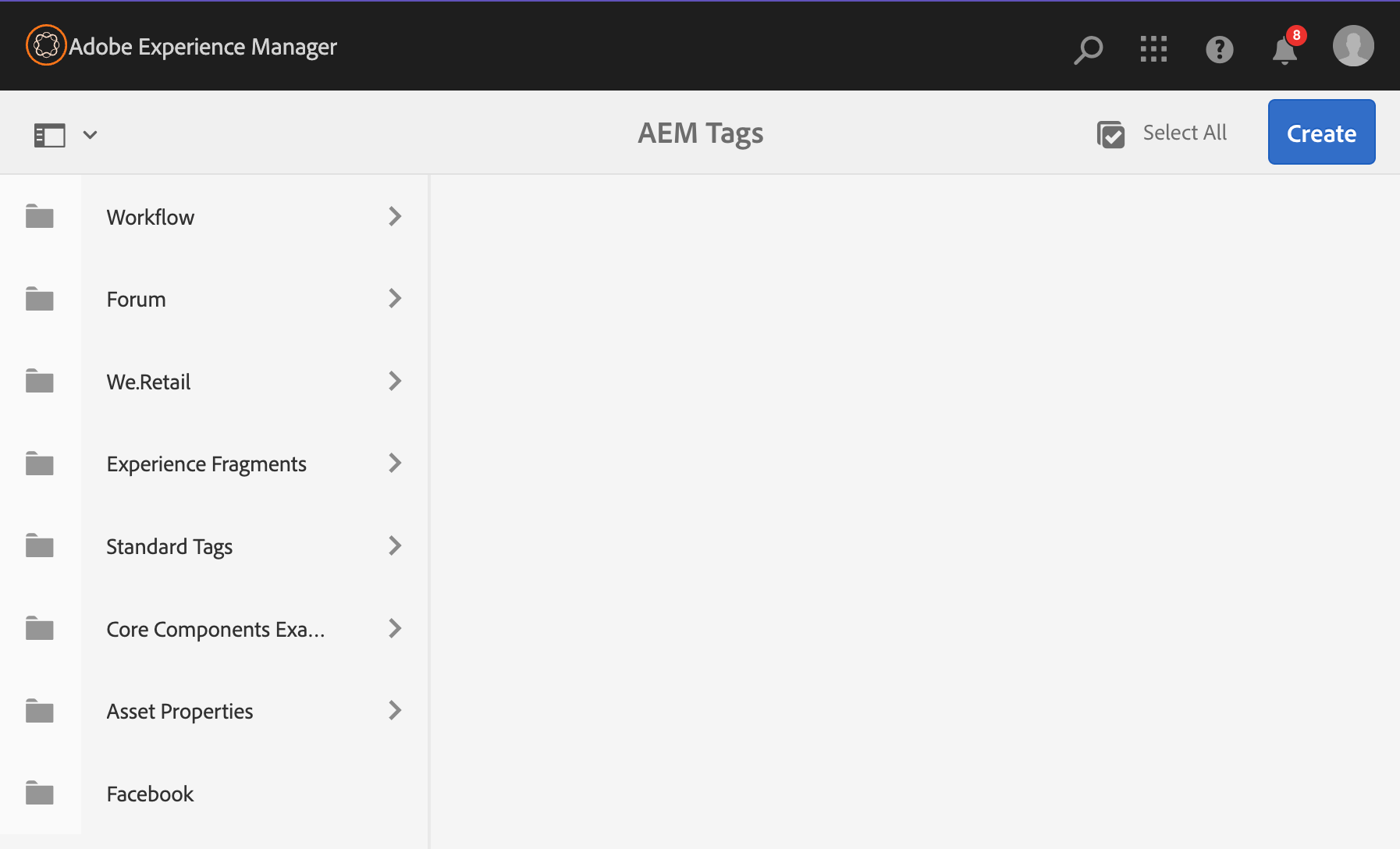
-
Create a new Namespace called “car-engines”.
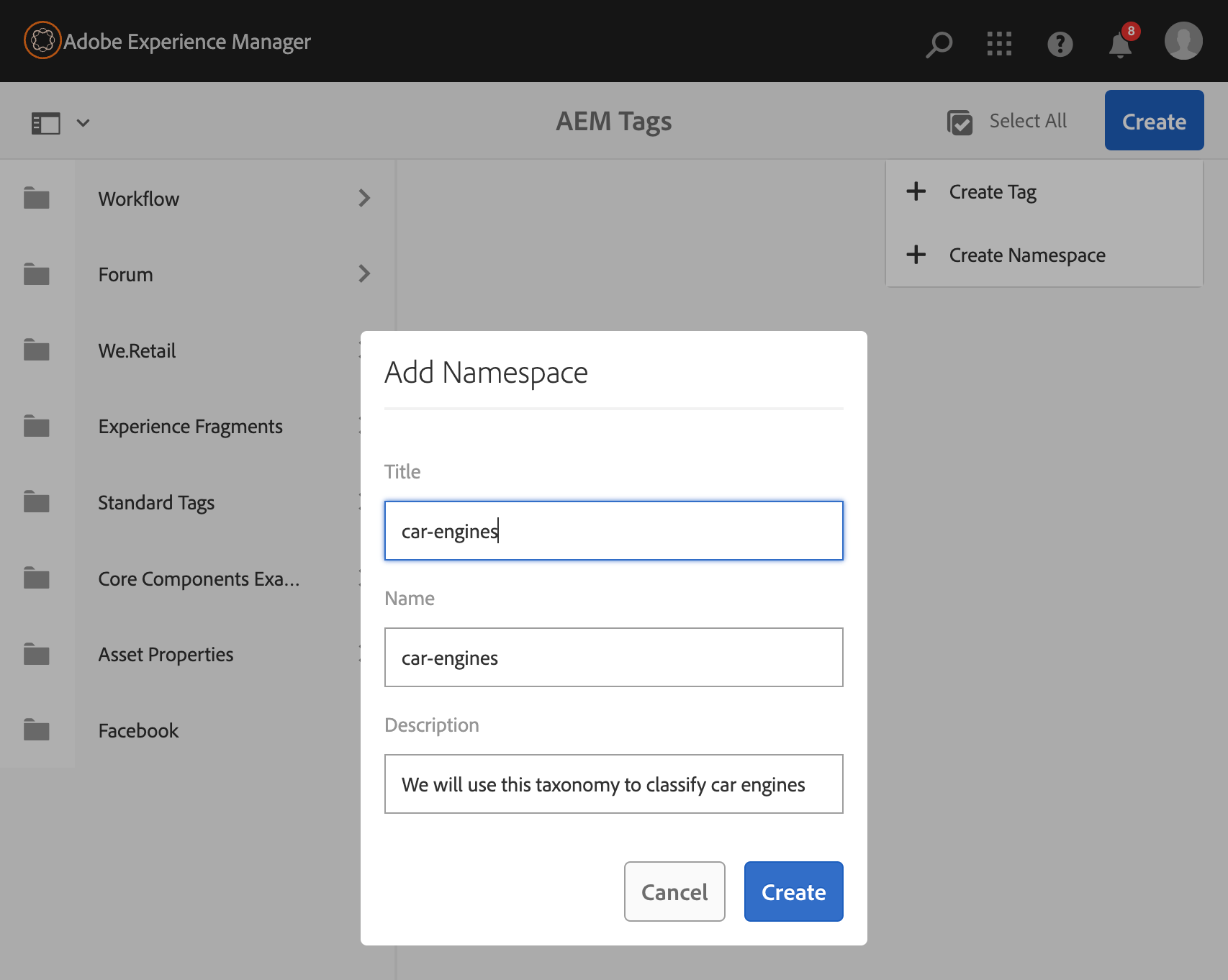
-
Select your new “cars” namespace and start adding three new tags: “electric”.
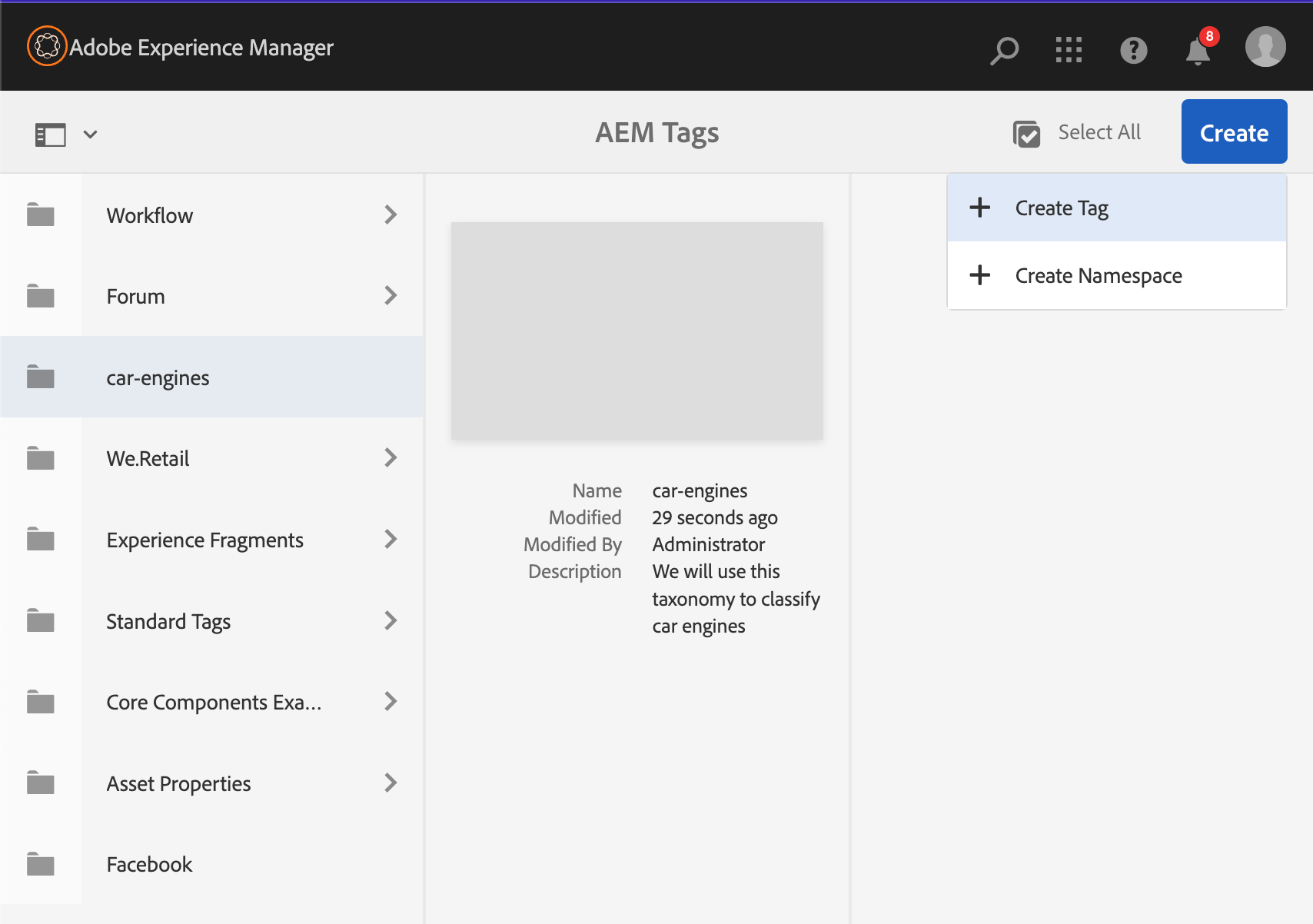
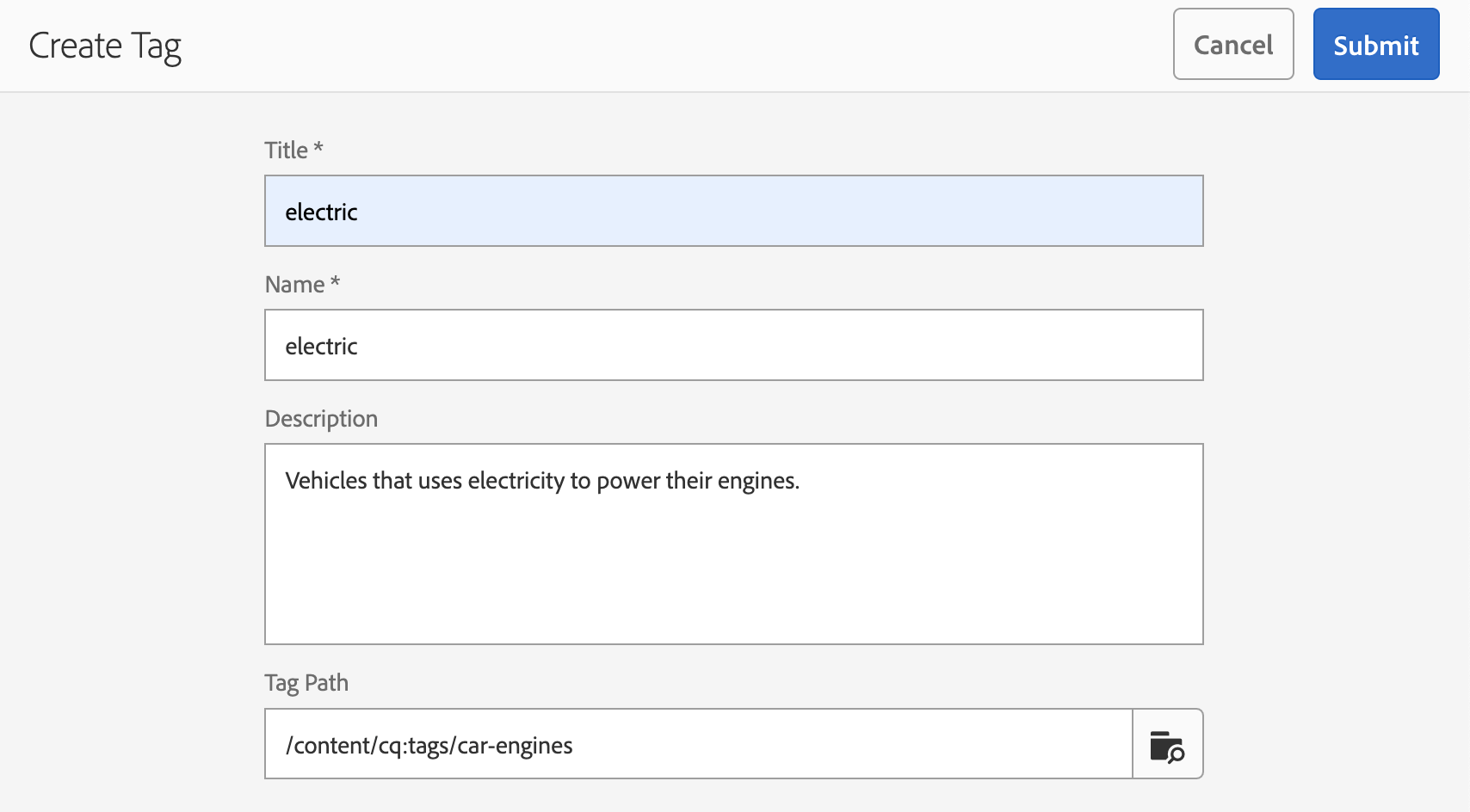
-
Do the same to add two new labels: “combustion” and “hybrid”.
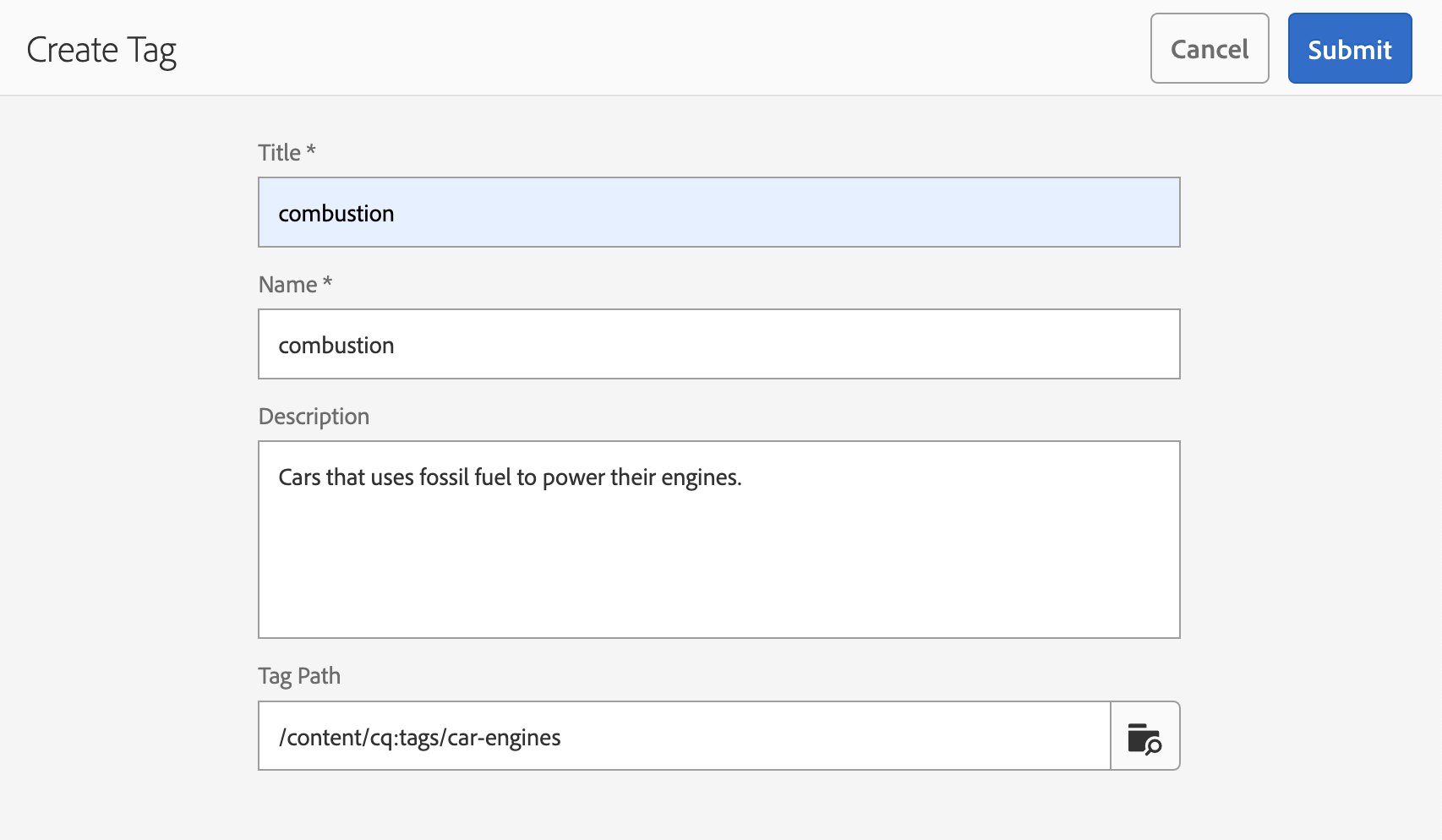
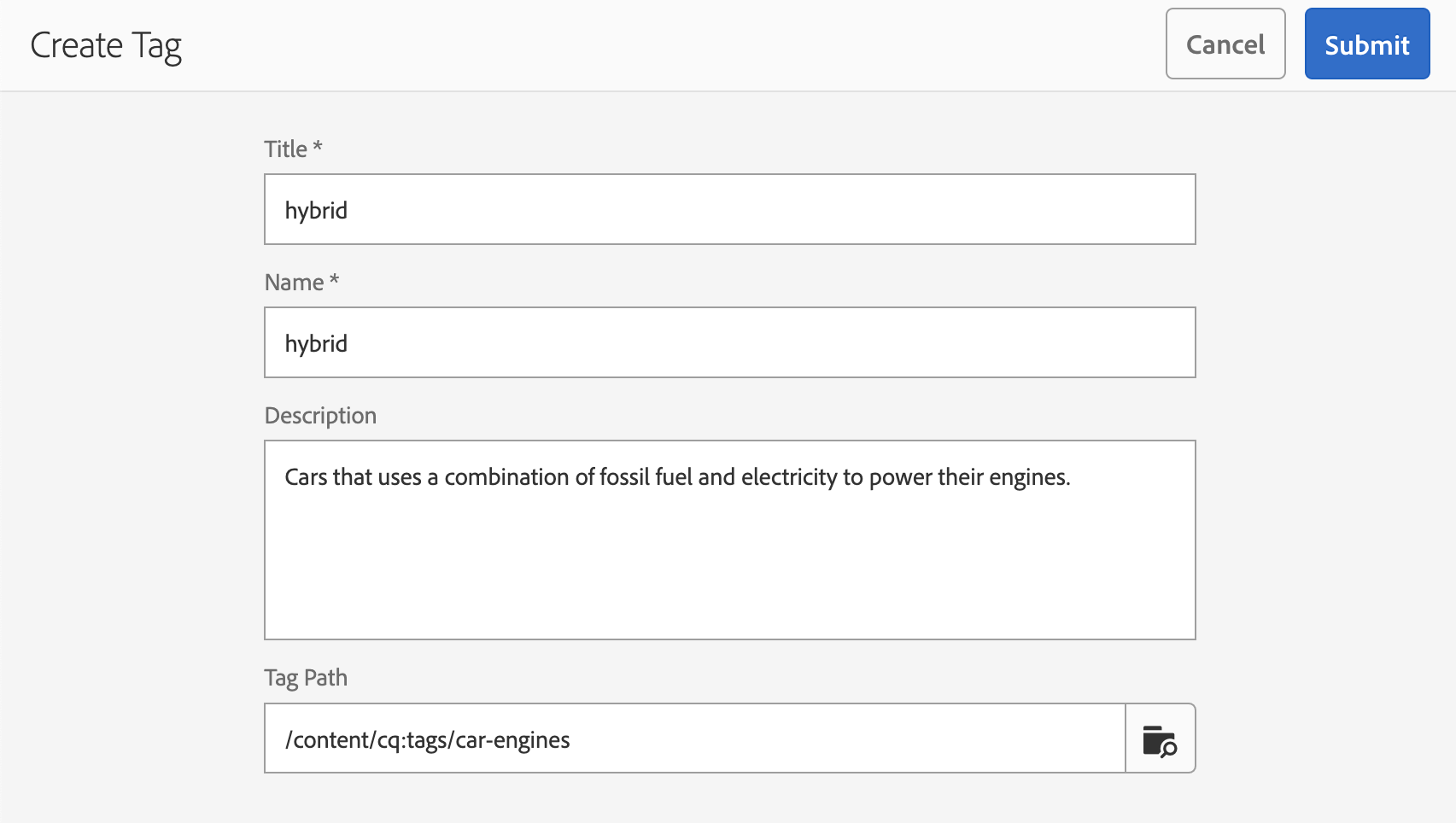
-
So, your newly created taxonomy will look like this:

-
Now you just need to go to your sites screen:
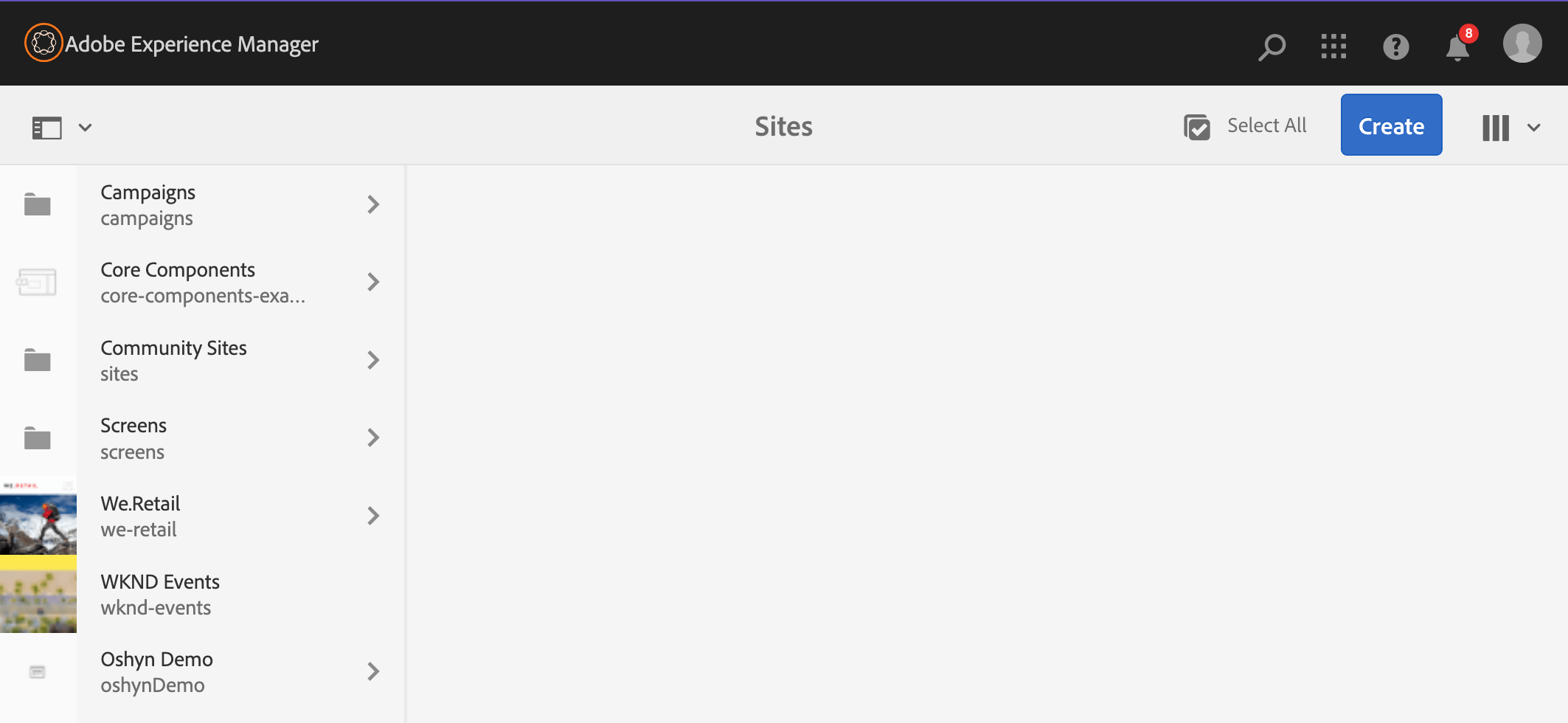
-
Navigate to any page, select it, click on properties.

-
Under the Basic tab you will find the Tags dropdown, click on it (you might need to cancel inheritance in some cases).
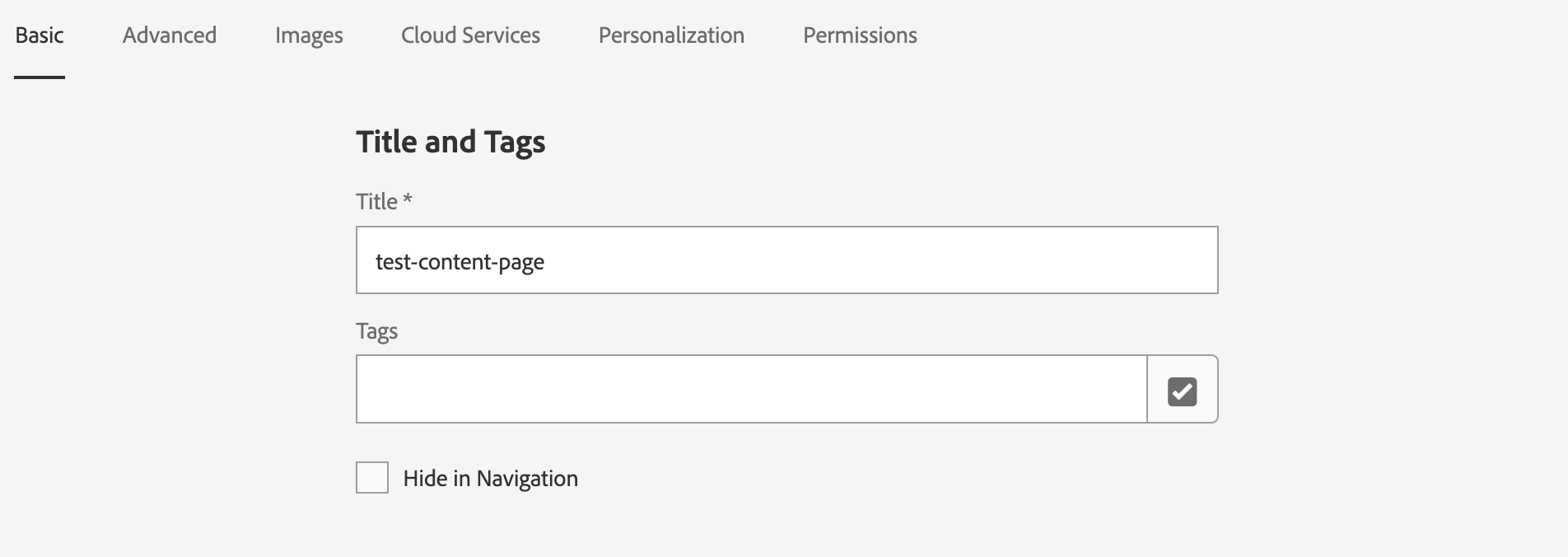
-
When you click on the tabs dropdown the list of available tags will be shown. Select the one that corresponds to the current page. And click the “Select” button.
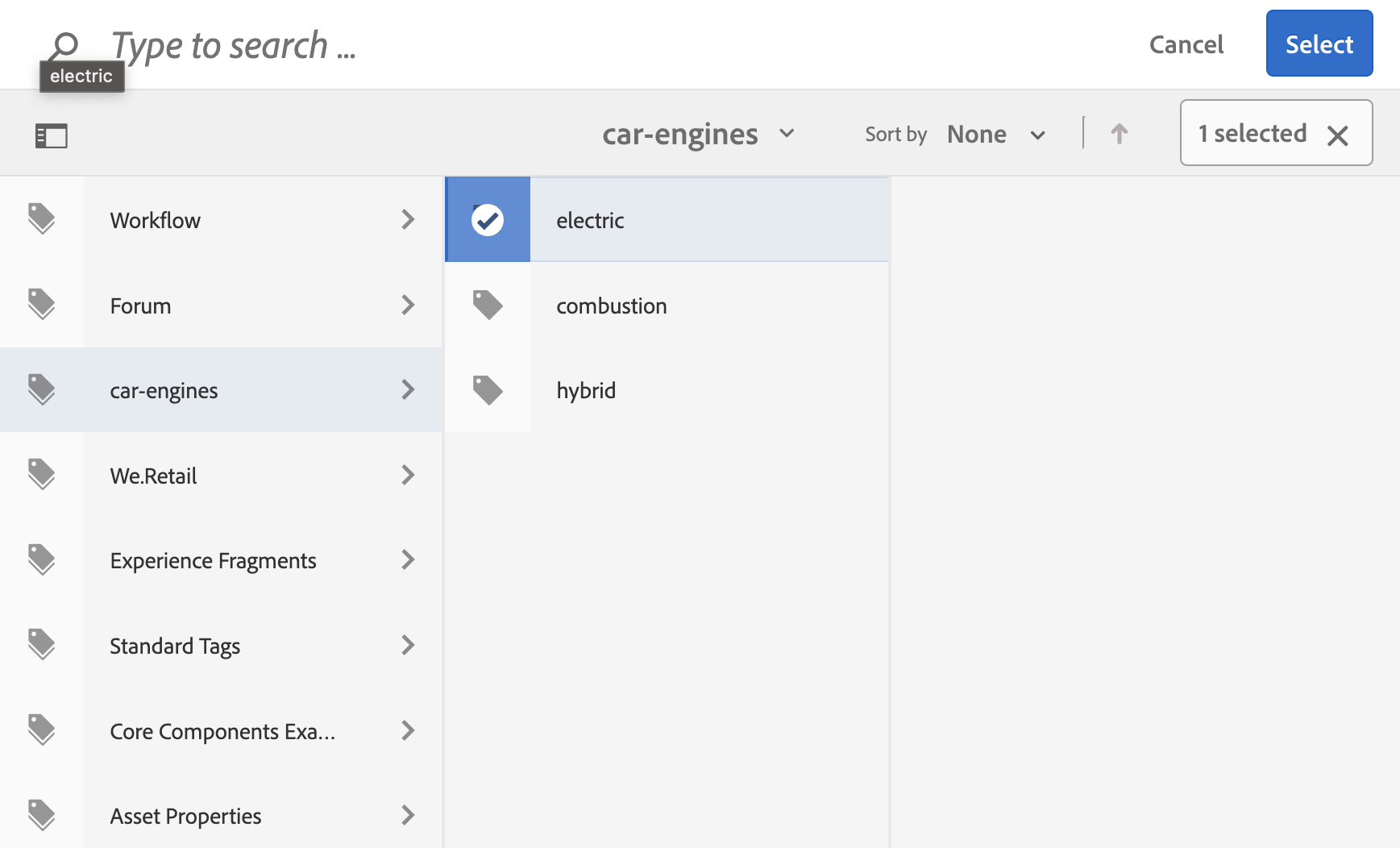
-
Now you will see your page tagged with the corresponding selected tag.
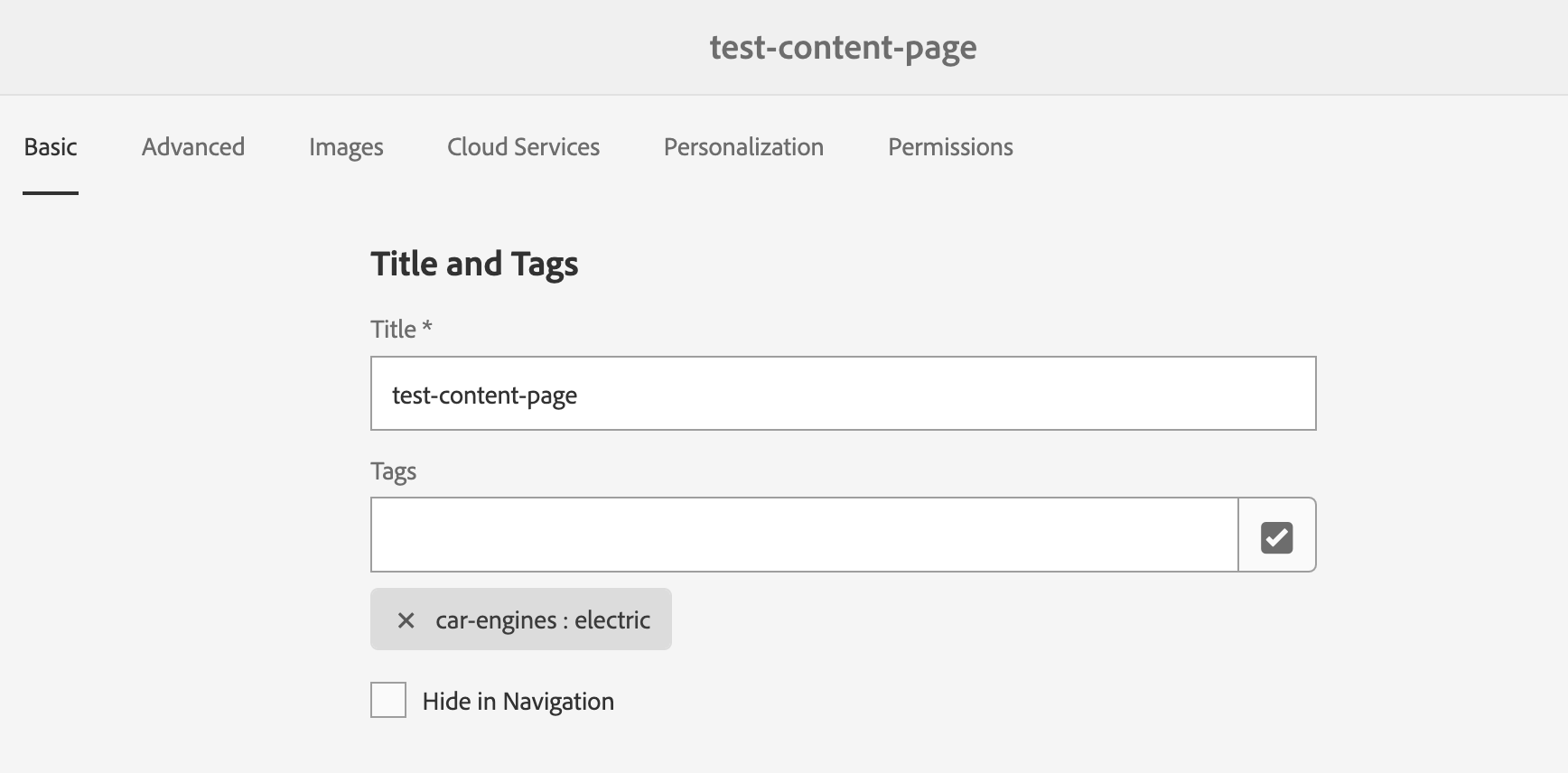
-
Repeat this process for every page you want to classify under your new taxonomy.
Note: You can repeat this process to add new taxonomies and you can tag your content with tags from more than one taxonomy.
Smart Tagging using AI:
Adobe AEM Assets offers a Smart Content Service that uses the artificially intelligent framework of Adobe Sensei AI to learn how to automatically tag the site’s content.
Smart Content Service requires training to recognize the site taxonomy to apply the right tags. For this, it uses Adobe Sensei AI framework in the background.
To use Smart Content Services it is required to integrate Experience Manager Assets with Adobe Developer Console to use Adobe Sensei, so it is required a Smart Content Service license purchased and enabled for the organization.
To learn more about Smart Tagging in AEM refer to AEM Smart Tags.
Wrapping Up
Nowadays, businesses produce massive amounts of content, making it challenging to search for specific assets and meet end-user requirements. Companies facing these situations must invest time in defining their content strategy and the taxonomy(ies) they will apply to their different types of content. As content increases over time, defining such taxonomy(ies) in the early steps of the content creation is recommended, but if that's not possible, the sooner, the better.
AEM empowers companies to create several dimensions of classification, allowing them to create different taxonomies that can be applied to content elements in the site using AEM Tags. It integrates the tags mechanism across several OOTB features, like the Search component.
Creating taxonomies using AEM Tags in AEM is straightforward, and tagging content is even easier. However, to get all the benefits related to it, they need to be aligned with a content strategy that is relevant to business and client needs.
Adobe is taking advantage of state-of-the-art Artificial Intelligence (AI) to automatically apply tags to content using a combination of their Adobe AEM Assets and Smart Content Service; we recommend you give it a try if your company creates large amounts of content on a regular basis.





